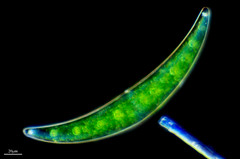Organism’s ability to distinguish strontium from calcium could help in dealing with nuclear waste.
Common freshwater algae might hold a key to cleaning up after disasters such as Japan’s Fukushima nuclear accident, scientists said yesterday at a meeting of the American Chemical Society in Anaheim, Calif.
The algae, called Closterium moniliferum, are members of the desmid order, known to microbiologists for their distinctive shapes, said Minna Krejci, a materials scientist at Northwestern University in Evanston, Illinois. But the crescent-shaped C. moniliferum caught Krejci’s eye because of its unusual ability to remove strontium from water, depositing it in crystals that form in subcellular structures known as vacuoles–an knack that could include the radioactive isotope strontium 90.
Strontium is very similar in properties and atomic size to calcium, so biological processes can't easily separate the two elements. That makes strontium 90 a particularly dangerous isotope: it can infiltrate milk, bones, bone marrow, blood and other tissues, where the radiation that it emits can eventually cause cancer.
“That’s what makes strontium 90 one of the dominant health risks of spent fuel for the first 100 years or so after it leaves the reactor,” says Krejci. The radioisotope has a half-life of about 30 years.
Unfortunately, reactor waste and accidental spills can contain up to 10 billion times more calcium than strontium, making it very difficult to clean up the strontium without also having to dispose of a mountain of harmless calcium. “We need a highly efficient and selective method of separating it,” says Krejci.









